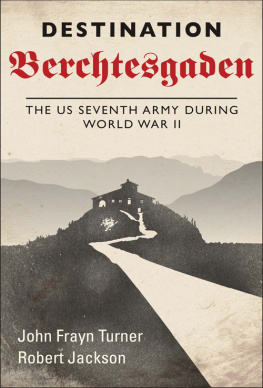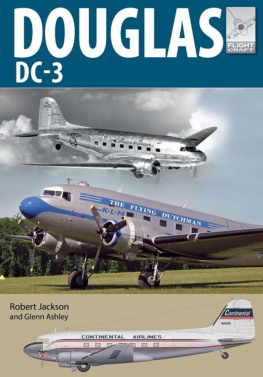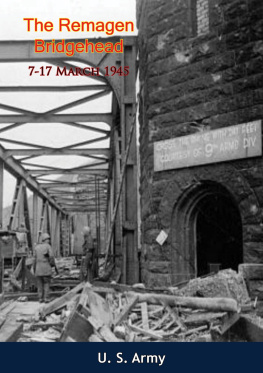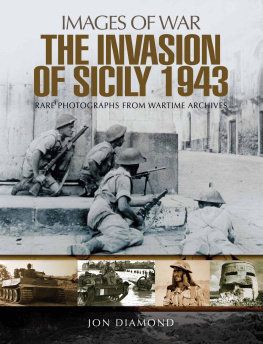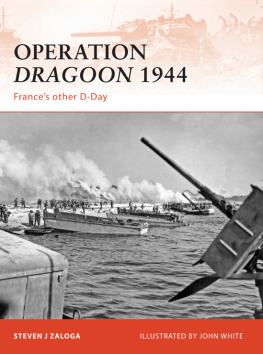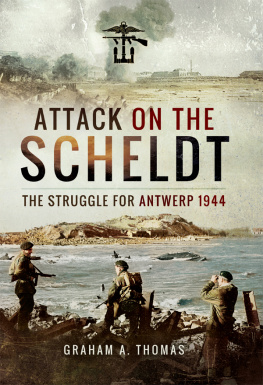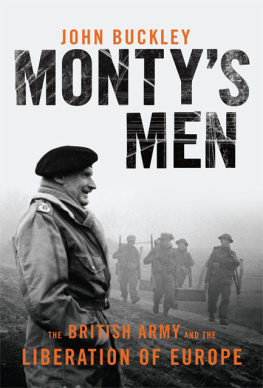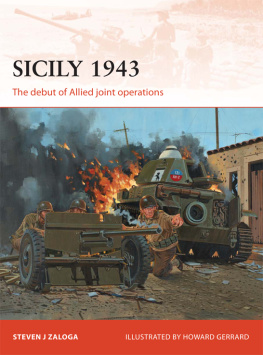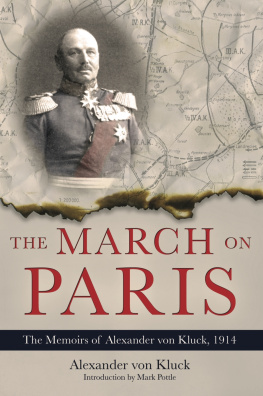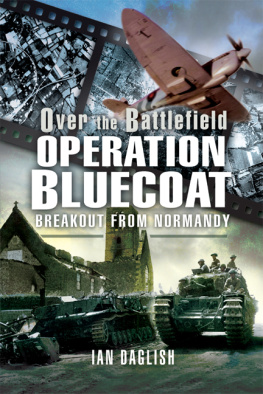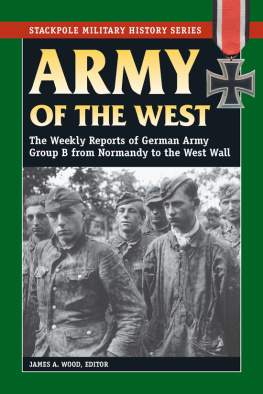DESTINATION
BERCHTESGADEN
The US Seventh Army during
World War II
John Frayn Turner & Robert Jackson
CONTENTS
CHAPTER 1
OPERATION HUSKY: THE INVASION OF SICILY
The storm came out of the west, sweeping across the length of the Mediterranean from the Straits of Gibraltar to lash the normally placid seas into a tumult. Around the rocky coast of Sicily, German and Italian sentries gazed at clouds that raced across the evening sky and wondered if the gale would last long enough to bring a temporary respite from the Allied bombers, which for weeks now had been pounding the islands defenses by day and night.
It was July 9, 1943, and after three and a half bitter years the tide of the war was at last beginning to turn against the Axis. In the Atlantic, hunter-killer task forces and aircraft combined to hound the U-boat wolfpacks to their deaths; on the Eastern Front, the German Sixth Army had been annihilated in the rubble of Stalingrad, and the Russians were massing their forces for an offensive in the Kursk salient; the once-proud Afrika Korps, trapped between the British Eighth Army and the American forces, had fought its last battle in Tunisia; and the heart of Germany was burning under the Anglo-American strategic bombing offensive. The Axis leaders knew beyond all doubt that it was now only a question of time before the Allies attempted to gain a foothold on mainland Europe, what they did not know yet was where the blow would fall.
On July 9, the German and Italian garrisons on Sicily had no way of knowing that they were to be the target for the first Allied invasion of Europe, or that the blow was only hours from being stuck. The decision to attack Sicily had, in fact, been reached only after considerable argument and discussion between the British and Americans. At the end of 1942, the British, foreseeing the elimination of the Axis forces from North Africa following the successful Allied landings there in November, envisaged exploiting this victory by pushing across the Mediterranean. They wanted to land in Sicily, Sardinia, the Italian mainland, or southern France; they also believed that such an action might persuade Turkey to enter the war on the side of the Allies. The Americans, on the other hand, wanted to build up their forces in Britain to launch a direct invasion across the Channel in 1943; they had no desire to continue the offensive in the Mediterranean, other than step up the strategic bombing of Italy to lower Italian morale.
It was this divergence of opinion that led to an Allied summit conference at Casablanca in January 1943, during which President Roosevelt, Prime Minister Winston Churchill, and their advisers met to thrash out a plan of campaign following the Allied victory in North Africa. The Americans, who now held the view that the North African campaign with its considerable drain on Allied resources would make a cross-Channel invasion in 1943 impossible in any case, finally agreed to an invasion of Sicily. At a later conference, held in Washington in May 1943, the Allied leaders agreed that they would consider operations beyond Sicily, in other words an invasion of Italy, only insofar as they were likely to expedite and facilitate a thrust across the Channel into northwest Europe.
In the end a form of compromise was reached; it was decided to launch a cross-Channel invasion in May 1944, while in the meantime attempting to knock Italy out of the war by using forces available in the Mediterranean Theatre though seven of these divisions were to be transferred to England by November 1943.
For the invasion of Sicily, the Combined Chiefs of Staff envisaged two task forces, one British and the other American. To command the British ground forces the Supreme Allied Commander, General Eisenhower, nominated General Sir Bernard Law Montgomery, who had led the Eighth Army in the 1,500-mile pursuit of the Afrika Korps from Egypt to Tunisia; while the Americans were to be commanded by Major General George S. Patton, Jr, who had led the Western Task Force in the invasion of North Africa, the II Corps in Tunisia, and who was now to lead the newly created United States Seventh Army in Sicily. Overall command of the Allied ground forces rested on the shoulders of General Sir Harold R. L. G. Alexander, while Admiral Sir Andrew B. Cunningham led the naval forces and Air Chief Marshal Sir Arthur Tedder the Air Forces.
Planning for the invasion continued throughout the spring of 1943. The Combined Chiefs recommended two simultaneous assaults, one near Palermo and the other near Catania; this would permit the seizure of two of the islands major ports and facilitate the capture of most airfields, allowing the two spearheads to then advance on Messina along the islands northern and eastern shores. There were, however, certain disadvantages to this idea; for one thing the two separate forces would be unable to support each other directly, and for another they would need a far greater numbers of troops and shipping to carry out their planned assault.
General Alexander, on the other hand, favored a concentrated assault by both task forces against the southeast coast of Sicily; however, his planners pointed out that the ports in this area would be inadequate to support the large weight of man and materiel required for the landing. The planners recommended two simultaneous assaults, one by the British in the southeast, the other by the Americans in the west; this followed roughly the lines laid down by the Combined Chiefs, but Montgomery objected on the grounds that a landing in the southeast would mean the stretching of his forces around 100 miles of coast between Gela and Catania to the point where they would be vulnerable to counterattack. He, like Alexander, favored a concentrated assault but on the east coast.
To try to resolve these and other arguments, Eisenhower called a conference of the military commanders in Algiers on April 29. This time, an officer representing Montgomery submitted a new plan which envisaged an Anglo-American assault on the southeast, with the British landing along the Gulf of Noto and the Americans going ashore on both sides of the Pachino Peninsular. On May 2, the invasion plan was finalized; the British would strike on the eastern coast from the Pachino Peninsula to Syracuse, the Americans along the Gulf of Gela from Licata to the Pachino Peninsula.
The invasion force assembled in North Africa during May and June. The British Eighth Army would open its assault with glider troops, who were to capture Ponte Grande and open the road to the taking of Syracuse; they were also, if possible, to capture some coastal batteries and a seaplane base. Another major coastal battery at Cape Murro di Porco, south of Syracuse, was to be eliminated by commandos as a prelude to the main attack.
Lieutenant General Sir Miles Dempseys XIII Corps was to put ashore the 5th Division, which would take Cassibile before turning north towards Syracuse; the corps left flank would be protected by the 59th Division, which was to capture Avola. The XXX Corps, under Lieutenant General Sir Oliver Leese, was to send in the 231st Infantry Brigade Group, the 51st Division, and the 1st Canadian Division against the Pachino Peninsula. After linking up with the Americans at Ragusa, this force was to push on to Palazzolo and Vizzini, extending northwards along the east coast to allow Dempsey to move a major part of his strength against Augusta and Catania.
The assault by Pattons Seventh Army was to begin with the dropping of elements of the 82nd Airborne Division the 505th Parachute Regiment and the 3rd Battalion of the 504th on Piano Lupo, approximately in the center of the American front and several miles inland from Gela. The task of the paratroops was to cut off the enemy approaches to the beaches during the early landing phase of the invasion, when the seaborne troops were extremely vulnerable to counterattack. The seaborne invasion was to take the form of a three-pronged thrust; on the right the 45th Division was go to ashore near the fishing village of Scoglitti and the 1st Division at Gela, both under the command of Major General Omar N. Bradleys II Corps, while on the left the 3rd Division would land at Licata.
Next page
